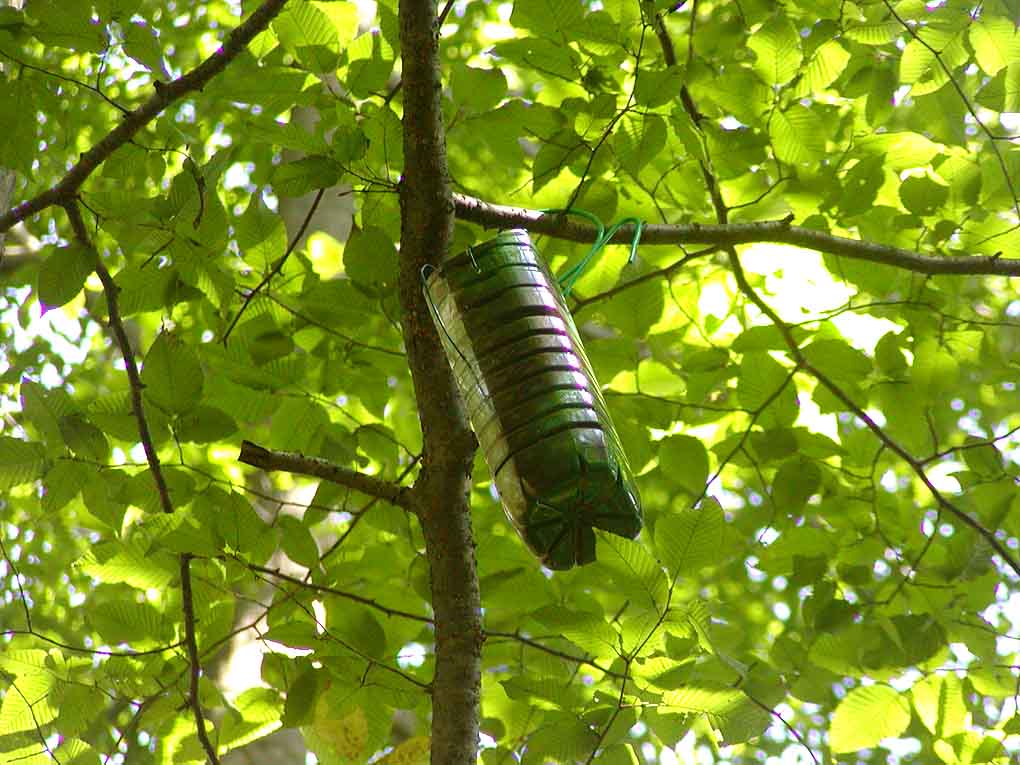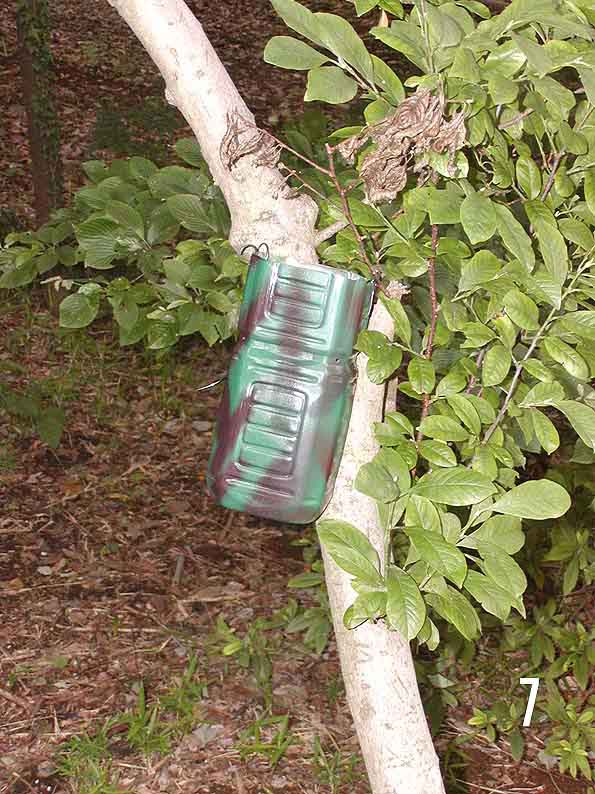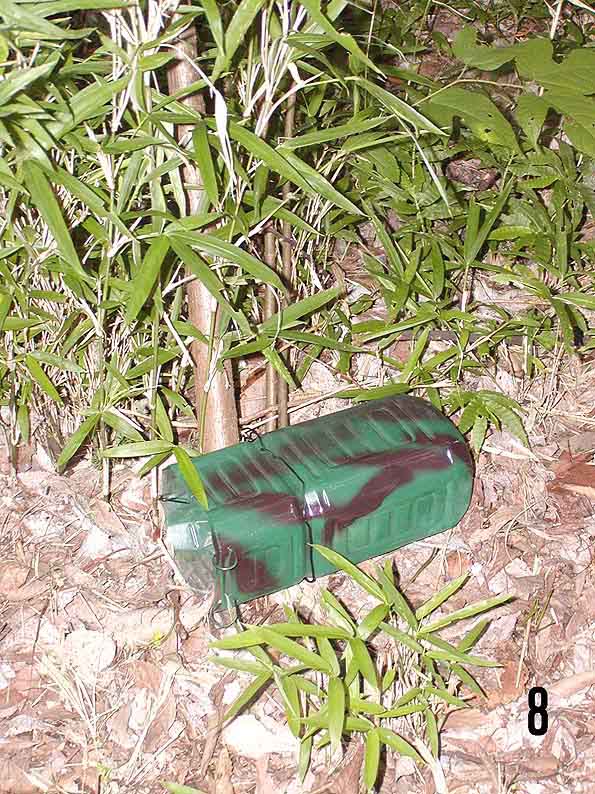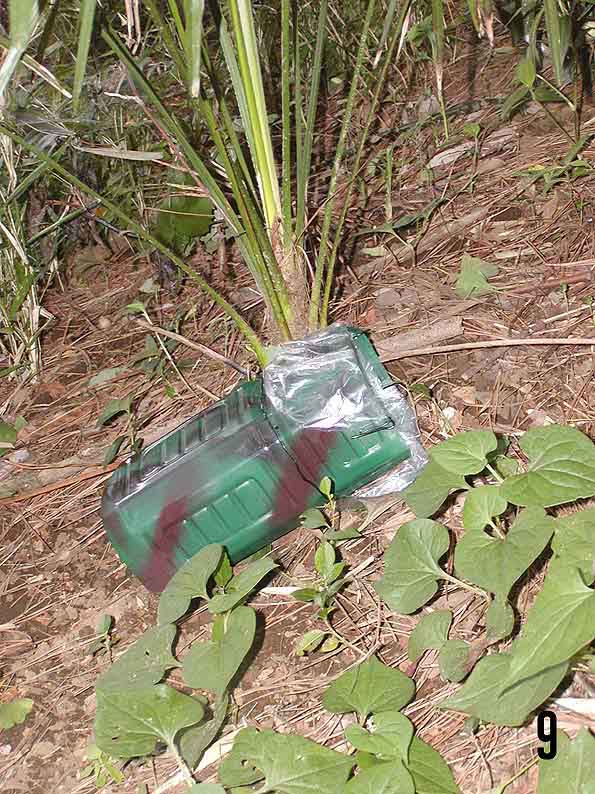TECHNIQUES OF NOMURA-HOIHOI
Japanese 日本語

A Nomura-hoihoi settled on high position of a tree using high position hook.
*The copyright of the following text is protected. It was already published in the Japanese coleopterological journal, "Saikaku-tushin". No one can use it without permittion of the publisher.
1) Technique and effect of Nomura-hoihoi as a banana-trap
[bait] One or two banana(s) for a bottle.
[using method] Peel the skin of banana, and put the skin and the fruit into the bottle. The fruit should be broken by fingers. The baited bottle should be fixed onto tree trunk by wire (Fig. 7), and collect it after 3 to 4 days. To cool and wet climate is not good for collecting.
[target, effect] In Lucanidae, Dorcus rectus and Prosopocoilus inclinatus are often collected by Nomura-hoihoi, next, Dorcus platymelus is common. Usually, D. hopei and Lucanus maculifemoratus cannot be collected by Nomura-hoihoi. It can collect many specimens of some cetonine species. In summer, many horned beetles can be collected. It is also able to get some species of Carabidae, Cerambycidae, Nitidulidae, and Velleius spp. (Staphylinidae).

Fig. 7. A Nomura-hoihoi as a banana trap.
2) As a Carabus-trap
[bait] "Sanagiko (powder of silkworm)" and "koppun (powder of cow bone)"
[using method] Put powder into the bottom of the bottle at 1-2 cm depth, and lay it with the mouth on the ground. Fix it by a wire connected with a tree root.
[target, effect] Many carabids and Pterostichus can be collected by it. Sanagiko is very good as a bait for Apotomopterus.

Fig. 8. A Nomura-hoihoi as a Carabus-trap.
3) As a carrion trap
[bait] Chicken meat and bone in a plastic bag.
[using method] Put the chicken in a plastic bag into the bottle, and use it as a Carabus-trap. Three to four days later, collect beetles from the plastic bag after the checken is decayed.
[target, effect] Many species of silphid beetles can be collected. Cholevines, Staphylinoids and many kinds of necrophagous beetles.

Fig. 9. A Nomura-hoihoi as a carrion trap on a slope.
4) As a dung trap
[bait] Animal dung or human's
[using method] Mr. Ryo Noda collected some coprophagous scarabaeids by the following dung trap. He put dear's dung 50 g with a shake of soil into the bottle, and insert it into a hole on the ground with the mouth at the level of the ground. The mouth of the bottle was covered by a plastic board against rainfall. It was collected a week later since setting.
[target, effect] After one year, many specimens of seven species of coprophagous scarabaeoids (Geotrupes, Aphodius), 28 species of Staphylinids and two species of Carabus (Ohomopterus)
5) As the other collecting method
[bait] Dried fishes/ edible mushroom
[using method] Put the bait and set the bottle around the habitat of the target insect.
[target, effect] In the case of dryed fish, you can get some large and middle sized diving beetles (Dytiscidae). It should be collected at the next morning. Many Dytiscus and Cybister beetles were collected by this style of Nomura-hoihoi. In the case of mushroom as the bait, you can collect some staphylinoid beetles.
Now, the author tried to use a Nomura-hoihoi as a high position bait trap using high position hook and a long rod. It is the same style as the high position FIT settled about 5 to 10m above the ground. We can make a high position hook by a 20 cm of the strong wire. It can collect many specimens of Cetonine, Lucanids and some Scarabaeids in higher woods.
Back to toppage